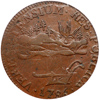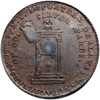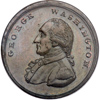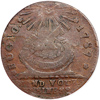
|
Sale 32
Pre-Long Beach Coin and Currency Auction
| Lot |
Photo |
Description |
Realized |
Lot 1484 |
 |
St. Patrick Copper Farthing. PCGS graded AU-50 Brown. Somewhat porous with interspersed charcoal gray and medium brown patina. Very scarce denomination in all grades. Pop 1; 2 in 53; 1 in 58 (PCGS # 42) .
The coinage of Mark Newby, who came to America from Ireland in 1681, was made legal tender by the General Assembly of New Jersey in May, 1682. The obverses show a crowned king kneeling playing a harp. The legent FLOREAT REX (May the King prosper) is separated by a crown.
Estimated Value $3,000 - 3,500.
View details and enlarged photos
Check results on similar lots
| Realized
$4,140 |
Lot 1485 |
 |
1776 Continental Currency. "CURRENCY". Pewter. PCGS graded EF-40 PQ. Old green holder. Gun Metal grey. A few marks but generally choice, historic, and attractive. Pop 4; 40 finer (PCGS # 794) .
The Continental Currency unit is the first large, dollar-size coin proposed for the United States. A private issue, whose types derive ultimately from designs popularized by Benjamin Franklin, its place of minting and ultimate coinage purpose remain obscure. Silver specimens, which are very rare, appear to have been struck to a close approximation of the value of a dollar on the New York standard ($1 = 8 shillings). Specimens struck in metal de cloche may have served some currency purpose, perhaps passing as pence (again, on the New York standard, at 12 pence to the shilling). The tin specimens, which are the most often encountered today, can have only a conjectural purpose. Possibly, they were intended as tokens, although it would be difficult to understand why they should be accepted in trade in lieu of good weight (or even, for that matter, no weight) halfpence, both royal and counterfeit. Possibly they were pattern strikes, as has been proposed elsewhere, but in this case, the number of patterns surviving surpasses the number of pieces struck with a currency intent. Another suggestion holds that with the shortage of copper early in the Revolutionary War, the metal necessary for the casting of cannons, the issue originally intended in metal de cloche was replaced by an issue in tin. At present, none of these questions is absolutely answered. Studies of the Continental Currency tend to point to New York as the place of minting.
Estimated Value $20,000 - 24,000.
View details and enlarged photos
Check results on similar lots
| Realized
$27,600 |
Lot 1486 |
 |
1787 New Jersey. Small planchet. NGC graded EF-45 Brown. Plain shield, knobless handles. Deep steel to purple-brown surfaces with clear date and most of the obverse legend plain (PCGS # 506) .
Estimated Value $800 - 900.
View details and enlarged photos
Check results on similar lots
| Realized
$720 |
Lot 1487 |
 |
1786 Vermont. "Vermontensium". PCGS graded AU-50 Brown. Variety with 7 trees and a sunray pointing between ES (RR-6). Better than average detail in the legends, with only a portion of MONT weakly impressed. All 7 trees are clearly seen, as is the face of the sun, the plow, and most of the date (although the 86 is partially off the planchet, as seen in the picture). Lovely reddish brown patina with no major imperfections or marks. Very scarce early Vermont issue (PCGS # 545) .
Estimated Value $4,500 - 5,000.
View details and enlarged photos
Check results on similar lots
| Unsold |
Lot 1488 |
 |
"1789" Mott token. Plain edge, thick planchet. PCGS graded EF-45. Pleasing reddish brown to steel brown color with some areas of planchet roughness (as made) around the outer border (PCGS # 603) .
Estimated Value $700 - 800.
View details and enlarged photos
Check results on similar lots
| Realized
$546 |
Lot 1489 |
 |
1799. Washington Funeral Medal in Silver. VF-35. Holed (as are all genuine examples as a ribbon was attached). A very attractive toned specimen of this foremost piece issued at the time of George Washington's Funeral in late-1799.
Washington died on December 14, 1799. Two funeral processions were held in Boston, the first was sponsored by the Masonic Lodge on Feb. 11, 1800 while the second was a general procession on February 22, 1800. According to Baker the Newburyport diemaker Jacob Perkins produced medals for each event. The two medals have similar obverses. The reverse of the medal for the Masonic procession, Baker 165, contains a legend in four lines with a small skull and crossbones at the bottom. The reverse of the medal offered here, thought to be for the general procession, displays a legend in two lines with an urn in the center. Angel Pietri has discovered the Boston Masonic Lodge still owns an urn made by Paul Revere that contains a lock of Washington's hair. Pietri examined the procession in detail, using contemporary accounts. In the diary of the Reverend William Bently, who gave the funeral sermon for the Mason's event there is a mention of Perkins, "on this occasion so well known for his excellent medals. of our General Washington." (Pietri, pp. 15 and 17). From this and the prominence of the urn in the procession Pietri suggests both Washington medals were produced and sold at the Masonic procession.
This example, in silver, is much rarer than those in white metal. It shows a bust of Washington facing left surrounded in a wreath on the obverse while the reverse displays a funeral urn and two semicircular lines of text. The medal was originally made with a small hole at the top, a small loop of wire would be put through the hole so the medal could be pinned onto clothing or suspended from a string. In this example the hole has been filled rather crudely.
Estimated Value $2,500 - 3,000.
Ex. Presidential Coin Auction, May 1997, Lot 165.
View details and enlarged photos
| Realized
$2,880 |
Lot 1490 |
 |
(1795) Washington "Liberty and Security" Penny. PCGS graded MS-64 Brown. Pop 10; 3 in 65BN. Glossy and attractive. The large format design with wide rims makes this a highly impressive Colonial issue. The obverse depicts a bust of Washington in high relief, more like that of a medal than a coin intended for circulation, while the reverse has a small eagle whose tail merges into a stylish shield with LIBERTY AND SECURITY above. Most impressive in this high grade! (PCGS # 767) .
Estimated Value $2,500 - 3,000.
View details and enlarged photos
Check results on similar lots
| Realized
$3,220 |
Lot 1491 |
 |
1787 Fugio Cent. Club rays, rounded ends. PCGS graded VF-20 Brown. Scarce club rays variety with rounded ends. This has the looks of having been dipped long ago but is now nicely toned a shade of brownish red. There is some very minor planchet lamination near the O of FUGIO but the coin is generally quite well made on an attractive planchet (PCGS # 904) .
Estimated Value $1,200 - 1,400.
View details and enlarged photos
Check results on similar lots
| Realized
$1,438 |
Lot 1492 |
 |
1834 Classic Head Half Cent. NGC graded MS-63 Brown. Delivered in 1835, the 1834 half cent is scarcer in all grades than the 1833 and much rarer in mint state. This has the usual light contact marks, with sleek, if somewhat uneven toning that ranges from faded reddish brown to glossy steel blue iridescence. Only the single Cohen-1 die pairing this year.
Estimated Value $270 - 290.
View details and enlarged photos
| Realized
$311 |
|
|